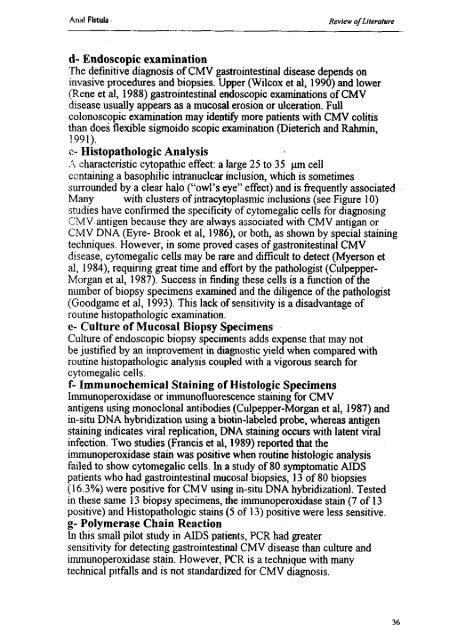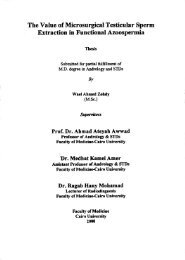A CLINICO.PATHOLOGICAL STUDY OF ANAL FISTULAE
A CLINICO.PATHOLOGICAL STUDY OF ANAL FISTULAE
A CLINICO.PATHOLOGICAL STUDY OF ANAL FISTULAE
You also want an ePaper? Increase the reach of your titles
YUMPU automatically turns print PDFs into web optimized ePapers that Google loves.
.a"nal Fbtula<br />
Review of Lllerature<br />
d- Endoscopic exflmination<br />
The definitive diagnosis of CMV gastrointestinal disease depends on<br />
invasive procedues and biopsies. Upper (Wilcox et al, 1990) and lower<br />
(Rene et al, 1988) gastrointestinal endoscopic examinations of CMV<br />
disease usually appears as a mucosal erosion or ulceration. Full<br />
colonoscopic examination may identify more patients with CMV colitis<br />
than does flexible sigmoido scopic examination (Dieterich and Rahmin,<br />
ree.l).<br />
*- Histopathologic Analysis<br />
.t characteristicytopathic effect: a large 25 to 35 pm cell<br />
cantaining a basophilic inffanuclEar inclusion, which is sometimes<br />
surrounded by a clear halo ("owl's eye" effect) and is frequently associated<br />
Muly with clusters of intracytoplasmic inclusions (see Figure l0)<br />
studies have confirmed the specificity of cytomegalic cells for diagnosing<br />
f"JIvlV.antigen because they are always associated with CMV antigan or<br />
CMV DNA (Eyre- Brook et al, 1986), or both, as shown by special staining<br />
techniques. However, in some proved cases of gastronitestinal CMV<br />
disease, cytomegalicells may be rare and difficult to detect (Myerson et<br />
al, 1984), requiring great time and effort by the pathologist (Culpepper-<br />
Ir4organ et al, 1987). Success in finding these cells is a function of the<br />
number of biopsy specimens examined and the diligence of the pathologist<br />
(Goodgamet al, 1993). This lack of sensitivity is a disadvantage of<br />
routine histopathologic examination.<br />
e- Culture of Mucosal Biopsy $pecimens<br />
Culture of endoscopic biopsy speciments adds expense that may not<br />
be justified by an improvement in diagnostic yield when compared with<br />
routine histopathologic analysis coupled with a vigorousearch for<br />
cytomegalicells.<br />
f- Immunochemicfll Staining of Histologic Specimens<br />
lmmunoperoxidase or immunofluorescence staining for CMV<br />
antigens using rnonoclonal antibodies (Culpepper-Morgan et al, 1987) and<br />
in-situ DNA hybridization using a biotinJabeled probe, whereas antigen<br />
staining indicates viral replication, DNA staining ocflrs with latent viral<br />
infection. Two studies (Francis et al, 1989) reported that the<br />
inrrnunoperoxidase stain was positive when routine histologic analysis<br />
failed to show cytomegalicells. In a study of 80 symptomatic AIDS<br />
patients who had gastrointestinal mucosal biopsies, l3 of 80 biopsies<br />
(16.3%) were positive for CMV using in-situ DNA hybridizationl. Tested<br />
in these same l3 biopsy specimens, the immunoperoxidase stain (7 of 13<br />
positive) and Histopathologic stains (5 of l3) positive were less sensitive,<br />
g- Polymerase Chain Reaction<br />
In this small pilot study in AIDS patients, PCR had greater<br />
sensitivity for detectin gastrointestinal CMV disease than culture and<br />
immunoperoxidase stain. However, PCR is a technique with many<br />
technical pitfalls and is not standardized for CMV diagnosis.<br />
r<br />
*<br />
#<br />
r<br />
36



